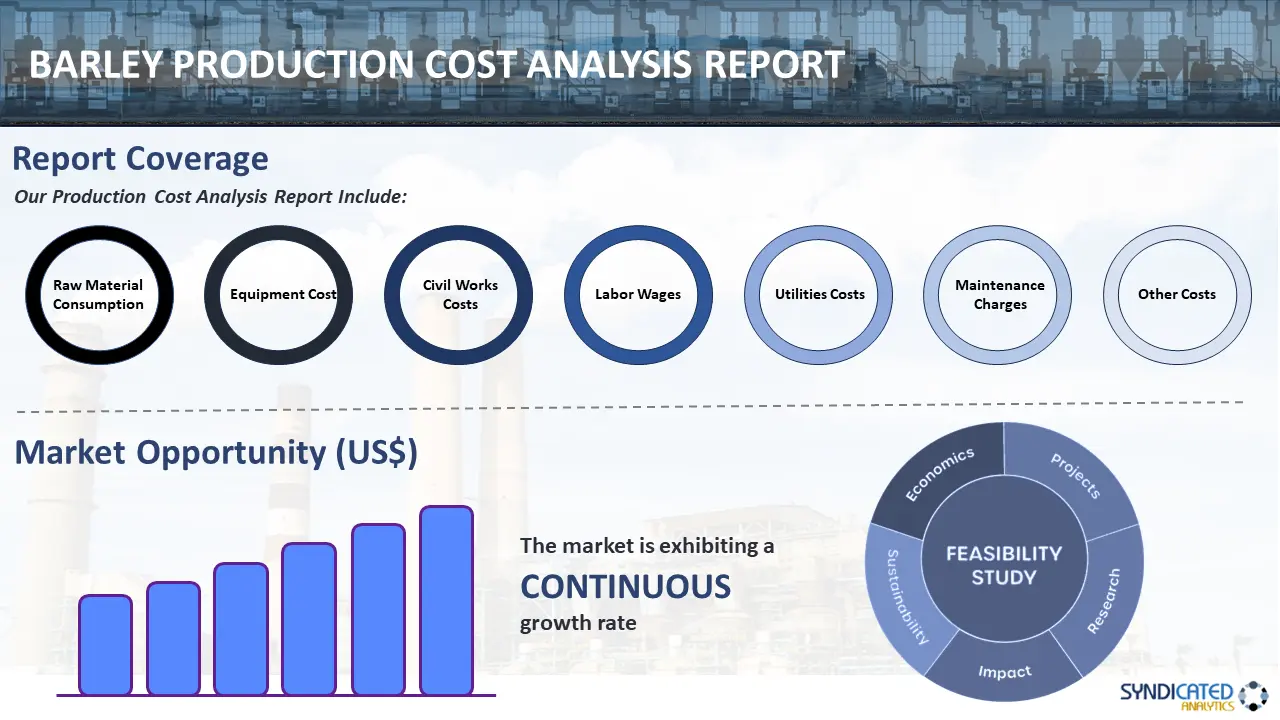
Barley Production Cost Analysis Report 2025 Edition: Industry Trends, Capital Investment, Price Trends, Manufacturing Process, Raw Materials Requirement, Operating Cost, and Revenue Statistics
Report Overview
The report by Syndicated Analytics, titled “Barley Production Cost Analysis Report 2025 Edition: Industry Trends, Capital Investment, Price Trend, Manufacturing Process, Raw Materials Requirement, Operating Cost, and Revenue Statistics,” presents an exhaustive analysis of both the operational expenses and revenue projections for setting up a barley manufacturing facility. Resulting from thorough primary and secondary research efforts, this document offers an in-depth exploration of market dynamics and the effects of the COVID-19 pandemic at both global and regional scales. The study meticulously examines price fluctuations, the balance of mass against required raw materials, and the critical unit operations essential to the barley production process. A detailed assessment of capital expenditures is provided, encompassing the breakdown of expenses related to raw materials, utilities, labor, packaging, transport, land acquisition, construction, and equipment. Additionally, the report forecasts profit margins and suggests strategies for setting optimal product prices. For those considering entering the barley market or current stakeholders, this report serves as a vital tool.

Barley Market Analysis:
The barley market is mainly driven by its increasing need as a feed grain for livestock, particularly in beef cattle, dairy cows, and poultry farming. The demand for this crop in animal feed is influenced by livestock production levels, feed preferences, and nutritional requirements. Further propelling the market expansion is the product's increasing use as a vital raw material in the malting sector, where it is malted to create malt, an essential component in the production of beer and spirits. Additionally, barley is widely utilized in a wide range of food products, such as baked goods, soups, and breakfast cereals, which is stimulating the global market. For instance, Salalah Mills Company launched barley flour, which is rich in vitamins, dietary fiber, and minerals. It is used to prepare baking items, such as yeast bread, flatbread, Omani bread, and sliced bread. Similarly, Simpsons Malt Limited announced a collaboration with Yara and Varda to promote sustainable barley malt production practices. This practice can aid in reducing the environmental impact of malt production.
Barley Market Trends:
Rising Usage in Animal Feed
Barley is primarily used as a feed grain for livestock, particularly in beef cattle, dairy cows, and poultry farming. The demand for barley in animal feed is influenced by livestock production levels, feed preferences, and nutritional requirements. Besides this, the need for meat and dairy products, particularly in developing countries, has been increasing, on account of the population growth and rising incomes. This trend propels the requirement for barley as a feed grain. For example, Canadian Bio-Systems Inc. (CBS Inc.) launched the Superzyme feed enzyme series to deliver high nutritional values in a wide range of animal feeds, including corn, soybean meal, wheat, barley, oats, canola meal, etc. Superzyme feed enzyme adds value to feeds and reduces potential waste. Furthermore, as per the USDA, close to 70% of barley traded is primarily used for the feed industry, and the lowest amount is utilized for human food. Switzerland-based Syngenta offers a hybrid feed barley variety colossus in the UK market. The hybrid variety enhances the performance of the barley grain.
Technological Advancements in Agriculture
Advances in agricultural technology, including precision farming techniques, remote sensing, and digital agriculture tools, enhance barley production efficiency and sustainability. These innovations support yield optimization, resource management, and farm-level decision-making. In line with this, the continuous advancements in agricultural technology, breeding techniques, and crop management practices improve barley yield potential, disease resistance, and quality attributes. Research investments drive innovation in barley cultivation and processing. For example, Dow Agrosciences introduced a cereal grain product called Paradigm Arylex, which is an active herbicide. This new product has been developed to be used in wheat, barley, triticale, and oats to regulate and control the growth of brassica weeds, deadnettle, Mexican poppy, fumitory, and several other broadleaf weeds. Moreover, BASF launched fungicide Sistiva for seed treatment on wheat and barley in Argentina. Sistiva provides around 45 days of control for post-emergent diseases of crops and allows farmers more flexibility for the foliar application.
Latest Industry News:
- Intergrain, a leading Australia-based barley breeding company, collaborated with two major Australian universities to improve barley yield stability in the face of climate variability and provide innovative breeding solutions that allow for the development of more productive crops.
- Ardent Mills, a flour-milling and ingredient company, and PepsiCo agreed to provide alternative grains, such as sorghum, barley, millet, and rye, which were the upcoming products of these companies. Therefore, both organizations will add more products containing these alternative grains as ingredients to their portfolio.
This report is essential reading for entrepreneurs, investors, researchers, consultants, and business strategists with interests in the barley industry. It offers a thorough examination of the current state of the industry and its future potential, supplying valuable information for informed decision-making and strategic planning. Serving as an invaluable resource, this report provides a detailed exploration of the barley industry, making it an indispensable tool for those looking to establish a strong presence in this dynamic sector.
Market Analysis
This section delves into the dynamics of the barley market, including overview, historical and current performance, and impact of COVID-19. It examines factors driving demand, identifies key market trends, and analyzes the price trend. This analysis provides stakeholders with critical insights into market opportunities and challenges.
| Market Overview | Provides a broad introduction to the barley market, including its definition, applications, and the role it plays in various industries. |
| Historical and Current Market Performance | Examines the market's development over time, highlighting trends, growth patterns, and significant changes in the market landscape. |
| Impact of COVID-19 | Analyzes the effects of the global pandemic on the barley market, including disruptions in supply chains, changes in demand, and long-term implications. |
| Market Forecast | Projects the future trajectory of the market based on current data, trends, and potential future developments. |
| Market Breakup by Segment | Segments the market based on product types, applications, or other relevant criteria, providing detailed insights into each segment's performance and prospects. |
| Market Breakup by Region | Discusses the market's geographical distribution, analyzing key regions and countries in terms of market size, growth opportunities, and challenges. |
| Price Trend | barley Price Trend: Examines the historical, current, and forecasted price trend of barley. Product Margins: Discusses the profitability and margins associated with barley production and sales. |
Barley Manufacturing Process
The manufacturing process segment offers a detailed overview of the production of barley, highlighting the technological methodologies employed, from raw material procurement to the final product. It outlines the sequence of operations involved and the equipment used, offering a comprehensive understanding of the manufacturing lifecycle.
| Product Overview | This section introduces barley, outlining its properties, applications, and significance in various industries. The overview establishes a foundational understanding of the product's role and value in the market. |
| Detailed Process Flow | A comprehensive depiction of the barley manufacturing process, from raw material intake to final product packaging, is provided. This includes a step-by-step guide through each stage of production, emphasizing critical control points and technological considerations. |
| Various Types of Unit Operations Involved | An examination of the unit operations integral to the manufacturing process. This segment delves into the technical aspects of each operation, detailing the equipment and methodologies employed. |
| Mass Balance and Raw Material Requirements | An analysis of the mass balance within the production process, highlighting the input of raw materials and output of final products and by-products. This section quantifies the raw materials required for a defined production volume, facilitating resource planning and optimization. |
Production Cost Analysis
This part of the report scrutinizes the various costs associated with the production of barley, including raw material costs, utilities, labor, and overheads. It breaks down the plant costs into detailed categories, providing an in-depth look at the factors contributing to the total production cost and their implications on pricing and profitability.
| Currency | US$ (Information can also be provided in the local currency) |
| Pricing and Purchase Options | Single User License: US$ 3450 Five User License: US$ 4450 Corporate User License: US$ 5450 |
| Customization Scope | The report can also be customized based on the requirement of the customer |
| Post-Sale Analyst Support | 12-14 Weeks |
| Delivery Format | PDF and Excel through email (We can also provide the editable version of the report in PPT/Word format on special request) |
Key Questions Answered in This Report?
- What are the various unit operations involved in manufacturing barley?
- What are the raw material requirements and costs in manufacturing barley?
- What are the utility requirements and costs in manufacturing barley?
- What are the manpower requirements and costs in manufacturing barley?
- What are the packaging requirements and costs in manufacturing barley?
- What are the transportation requirements and costs in manufacturing barley?
- What are the land requirements and costs in manufacturing barley?
- What are the construction requirements and costs in manufacturing barley?
- What are the profit margins in barley?
- What should be the pricing mechanism of barley?
Seeking a Tailored Project Report?
While we have endeavored to create a comprehensive report, we acknowledge that each stakeholder may possess unique requirements. In light of this, we offer the option to customize the report to align with your specific needs. You can convey your business specifications to our consultants, and we will furnish you with a personalized scope tailored precisely to your requirements. Some of the common customizations that our clients often request include:
- Tailoring the report to suit the country/region where you intend to establish your plant.
- Adapting the manufacturing capacity of the plant to meet your specific needs.
- Customizing machinery suppliers and costs to align with your requirements.
- Incorporating any additional elements into the existing scope as per your specifications.
Why Choose Syndicated Analytics:
- Our reports offer valuable insights to stakeholders, enabling them to make informed business decisions confidently.
- We maintain a robust network of consultants and domain experts spanning over 100 countries across North America, Europe, Asia Pacific, South America, Africa, and the Middle East.
- Our extensive database includes equipment and raw material suppliers from major continents, ensuring comprehensive coverage.
- We diligently track and update critical factors such as land costs, construction costs, utility expenses, labor costs, and more, across more than 100 countries worldwide.
- Syndicated Analytics is the trusted partner of choice for leading corporations, governments, and institutions globally. Our clientele ranges from small startups to Fortune 500 companies.
- Our dedicated in-house team comprises experts in various fields, including engineers, statisticians, modeling specialists, chartered accountants, architects, and more. They play a pivotal role in developing, expanding, and optimizing sustainable manufacturing facilities worldwide.
Purchase Options
Ask For Customization
Personalize this research
Triangulate with your own data
Get data as per your format and definition
Gain a deeper dive on a specific application, geography, customer or competitor
Any level of personalization
Get in Touch
Call us on
US: +1-213-316-7435
Uk: +44-20-8040-3201
Drop us an email at
sales@syndicatedanalytics.com